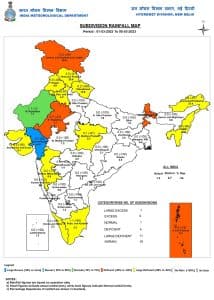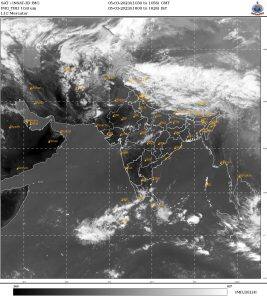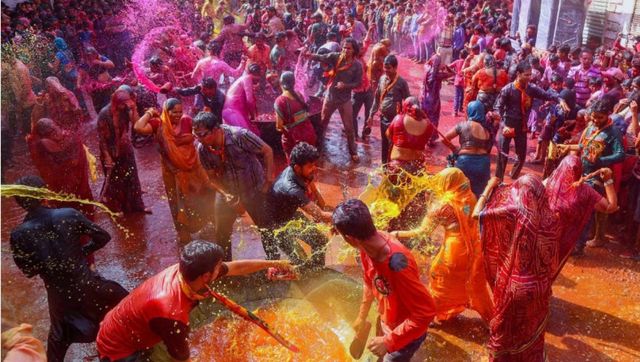The month of February ends on a historical hot note in India, 2023 turns out to be another year for India with no spring, as per the data of the Indian Meteorological Department, India’s maximum temperature for the month of February was 29.54°c against the normal of 27.80°c, this is the highest maximum temperature country ever experienced since the proper meteorological record keeping begin in 1901. The previous highest records are also from the 21st century, 29.48°c during 2016, 29.31 during 2006, 29.24°c during 2017, 29.23°c during 2009 evident that warming is soft killing the season of spring in the past couple of decades. The average maximum temperature had the highest anomaly of 3.40°c in northwest India, where February 2023 ends with the average maximum temperature of 24.86°c against the normal of 21.6°c. Check-out top 20 all time records broken in the month of February this year: 1) Mangalore recorded 38.8°c on 27th February, breaking the previous monthly record of 38.7°c from 16th February 2017. 2) Narnaul recorded 35.0°c on 21st February, breaking the previous monthly record of 34.5°c from 27th February 2004 and 24-25th February 2021. 3) Varanasi recorded 35.5°c on 21st February this is the second highest maximum temperature after 1884 when it touched 36.1°c. 4) Kota recorded 37.4°c on 20th February, breaking the previous monthly record of 37.0°c from 26th February 1973. 5) Safdarjung ( Delhi) recorded 33.6°c on 20th February, the 3rd highest monthly temperature since 1969. The all-time record is 34.1°c from 26th February 2006. 6) Amreli recorded 39.4°c on 19th February, breaking the previous record of 39.0°c from 28th February 2009. 7) Rajkot recorded 39.8°C on 19th February, hitting the second highest monthly maximum temperature while the all-time record is 40.0°c from 28th February 1953. 8) Shimla 23.2°C as maximum temperature and 14.4°c minimum temperature on 18th February breaking the previous all time record of 22.6°c (Max) and 14.2°c (Min) from 23rd February 2015. 9) Bhuntar recorded 29.7°c on 18th February, breaking the previous all time record of 28.2°C from 27th February 2018. 10) Surendranagar recorded 39.3°C on 18th February, breaking the previous all time record of 39.0°c from 26th February 1966. 11) Naliya recorded 38.6°C on 18th February, breaking the previous all time record of 38.2°C from 19th February 2017. 12) Porbandar recorded 39.0°c on 17th February, breaking the previous all time record of 38.4°c from 11th February 1984. 13) Kandla AP recorded 39.1°c on 17th February, breaking the previous record of 37.8°c from 19th February 2017. 14) Ratnagiri recorded 39.4°C on 17th February, breaking the previous all time record of 39.3°C from 25th February 2017. 15) Bhuj recorded 40.3°C on 16th February 2023, breaking the previous record of 39.0°C from 19th February 2017. 16) Solan recorded 29.5°c on 16th February 2023, breaking the previous record of 28.5°c on 26th February 2021. 17) Bikaner recorded 37.8°c on 17th February, this is the second highest maximum temperature ever recorded, the all time record is 38.2°C from 28th February 1953. 18) Jodhpur recorded 36.9°c on 23rd February this is the second highest maximum temperature ever recorded, the all time record is 37.2°C from 28th February 1953. 19) Jaisalmer recorded 37.5°c on 19th February, this is the second highest maximum temperature ever recorded, the all time record is 37.8°c from 27th February 1953. 20) Kalpa recorded 17.6°c on 18th February, this is the second highest maximum temperature ever recorded, the previous all time record is 18.0°c from 11th February 1993. Following the trends from February, March too starts on a record breaking note for southern parts of the country, On 4 March Karwar in Karnataka recorded a maximum temperature of 40.2°c breaking the previous all time record of 39.6°c from 1 March 2000. Honnavar recorded 39.4°c breaking the previous all time record of 38.8°c from 6 March 2013. March and April are the hottest months in Kerala, Karnataka and it starts on a historical note, wherever the heat is moving it is setting new records, this hints for a very harsh summer ahead for the majority of the country in the key months of May and June. A western disturbance has affected Himalayas along with a cyclonic circulation formed over south west Gujarat on Saturday resulted in rains and hailstorms in various parts of Rajasthan and Madhya Pradesh on Saturday. Rainfall in stations of Rajasthan during the last 24 hours till 8:30 am on 5 March: Jayal: 16mm Makrana: 8mm Abu Road: 8mm Asnawar: 7mm Jhalrapatan: 6mm Sangod: 6mm Ramganj mandi: 5mm Mandlagarh: 5mm Bundi: 4mm Bhilada: 4mm Merta city: 4mm Sikar: 3mm Pugal: 3mm Degana: 3mm Chattargarh: 3mm Chittorgarh: 2mm Kota: 2mm Ajmer: 2mm March marks the beginning of the pre monsoon season on the records of the Indian Meteorological Department and it lasts till May end as June marks the beginning of monsoon season on paper. March is not a typical rainy month for many parts of the country except the western Himalayas and north east India where usually wet weather starts to set in. In the period of 1-5 March the country as a whole recorded a total of 1.2mm rainfall against the normal of 4.7mm, -74% departure from normal. Subdivision wise seasonal rainfall in the period of 1-5 March, 2023:
- Southern Peninsula: Actual 0.3 mm against the average of 1.9 mm, -86% departure from normal.
- East and North East India: Actual 0.2 mm against the average of 6.7 mm, -96% departure from normal.
- North West India: Actual 3.6 mm against the average of 8.7 mm, -58% departure from normal.
- Central India: Actual 0.0mm against the average of 1.7mm, -97% departure from normal.
[caption id=“attachment_12247742” align=“alignnone” width=“390”] Seasonal rainfall in the period from 1st to 5th March, 2023[/caption] Current synoptic features influencing weather in India as on 5 March:
Seasonal rainfall in the period from 1st to 5th March, 2023[/caption] Current synoptic features influencing weather in India as on 5 March:
- The Western Disturbance as a trough in middle and upper tropospheric westerlies with its axis at 5.8 km above mean sea level now runs roughly along Long. 66°E to the north of Lat. 23°N.
- The induced cyclonic circulation over north Gujarat and neighbourhood now lies over north Gujarat and adjoining southwest Rajasthan and extends up to 1.5 km above mean sea level.
- A trough runs from south Konkan to north Madhya Maharashtra at 1.5 km above mean sea level.
- A fresh feeble western disturbance is likely to affect Western Himalayan Region from 07 March 2023.
All India weather forecast for the Holi week till 11 March, 2023: As the upcoming week progresses Indians are all set to celebrate the festival of colours Holi on Tuesday and Wednesday and weather forecast plays a very crucial role in planning a way ahead when citizens will be celebrating in the outdoors. Heatwave in South, warmth in North and East, rains and hailstorms in Central India is why to expect in this coming week: A pair of western disturbance and induced cyclonic circulation over Gujarat has formed a lower level wind instability over central and western states of the country that is most likely to influence the weather conditions in Rajasthan, Gujarat, Madhya Pradesh and Maharashtra during 6 to 9 March. Moderate thunderstorms, rains and hailstorms are very likely over the aforementioned states possibly affecting the ready to harvest standing rabi crops of the farmers, very less known Unseasonal March rains to impact these states during the Holi festivities generally the weather remains clear and warm during this time of the year. [caption id=“attachment_12247772” align=“alignnone” width=“436”] Satellite imagery shows isolated thunderstorms over Madhya Pradesh on the evening of 5 March, activities to increase 6 March onwards[/caption] Already sizzling southern parts of the country will heat up further during the upcoming week with the possibility of heatwave in parts of coastal and interiors of Karnataka and Kerala with maximum temperature reaching as high as 40°c. Stations in Tamil Nadu, Telangana, Andhra Pradesh, Goa would record similar hot weather conditions with maximum temperatures falling in the range of 35 to 40°c, clear sky Conditions will prevail with negligible probability of rains since no active weather system will impact the region till 11 March. North India where a large number of the population will be celebrating Holi in the outdoors will experience warm weather conditions as the maximum temperature from 7 to 9 March will be in the range of 29 to 33°c in Uttar Pradesh, Delhi NCR, Haryana and Punjab. The weather instability in central India could slightly impact weather conditions in western Uttar Pradesh, South Haryana up to Delhi NCR during the evening and night of 8th March with isolated thunderstorms in the region. In the upcoming week most parts of east India will experience dry and warm weather conditions as maximum temperatures are likely in the range of 34 to 38°c in Odisha, Jharkhand, Bihar and West Bengal. The rains that have picked up in late February would reduce significantly in the upcoming week over the North East India except Arunachal Pradesh, Assam and Sikkim where light to moderate rains will occur at a few places. Any widespread or significant rains will not occur in the seven sisters states until a strong western disturbance or moist southerly winds influence the region directly which is not likely at least till mid March. The author, better known as the Rohtak Weatherman, interprets and explains complex weather patterns. His impact-based forecasts @navdeepdahiya55 are very popular in north India. Read all the
Latest News
,
Trending News
,
Cricket News
,
Bollywood News
, India News
and
Entertainment News
here. Follow us on
Facebook
,
Twitter
and
Instagram
.
Satellite imagery shows isolated thunderstorms over Madhya Pradesh on the evening of 5 March, activities to increase 6 March onwards[/caption] Already sizzling southern parts of the country will heat up further during the upcoming week with the possibility of heatwave in parts of coastal and interiors of Karnataka and Kerala with maximum temperature reaching as high as 40°c. Stations in Tamil Nadu, Telangana, Andhra Pradesh, Goa would record similar hot weather conditions with maximum temperatures falling in the range of 35 to 40°c, clear sky Conditions will prevail with negligible probability of rains since no active weather system will impact the region till 11 March. North India where a large number of the population will be celebrating Holi in the outdoors will experience warm weather conditions as the maximum temperature from 7 to 9 March will be in the range of 29 to 33°c in Uttar Pradesh, Delhi NCR, Haryana and Punjab. The weather instability in central India could slightly impact weather conditions in western Uttar Pradesh, South Haryana up to Delhi NCR during the evening and night of 8th March with isolated thunderstorms in the region. In the upcoming week most parts of east India will experience dry and warm weather conditions as maximum temperatures are likely in the range of 34 to 38°c in Odisha, Jharkhand, Bihar and West Bengal. The rains that have picked up in late February would reduce significantly in the upcoming week over the North East India except Arunachal Pradesh, Assam and Sikkim where light to moderate rains will occur at a few places. Any widespread or significant rains will not occur in the seven sisters states until a strong western disturbance or moist southerly winds influence the region directly which is not likely at least till mid March. The author, better known as the Rohtak Weatherman, interprets and explains complex weather patterns. His impact-based forecasts @navdeepdahiya55 are very popular in north India. Read all the
Latest News
,
Trending News
,
Cricket News
,
Bollywood News
, India News
and
Entertainment News
here. Follow us on
Facebook
,
Twitter
and
Instagram
.
)